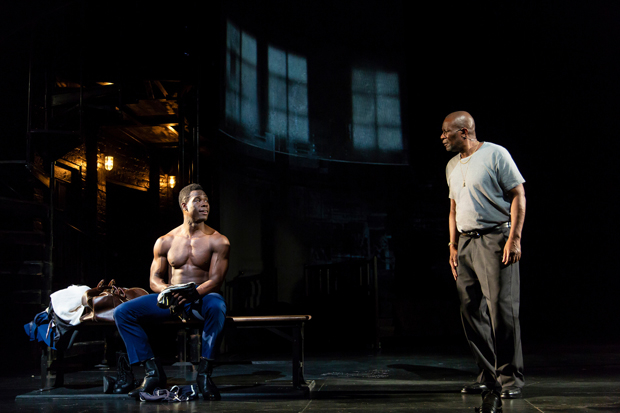Forbidden Sex, Violence, and Regrets in Man in the Ring

(© T. Charles Erickson)
Emile Griffith was a world-champion prizefighter who killed a man in the ring in 1962. He went on to claim titles in three divisions before he was forced to retire because of pugilistic dementia, the result of too many blows to the head and a vicious beating by a homophobic street gang. Michael Cristofer's compelling play Man in the Ring, based on Griffith's life story, is shot through with poetry and truth. Under the adroit direction of Michael Greif, with John Douglas Thompson and Kyle Vincent Terry perfectly cast as the older and younger Emile, respectively, the Huntington Theatre Company production packs an emotional wallop.
As a child in the US Virgin Islands, Griffith was abandoned by his father and was later left behind with a sadistic cousin by his mother, Emelda, who ran off to New York. He was also sexually abused by an older man before leaving the island to join her. Griffith, who died in 2013, was bisexual during a period when an athlete competing in the macho world of professional boxing could never admit to having sex with men.
Despite the traumas of his early life and the complexities of hiding his sexual preferences, Griffith was known for his sweetness, his baseball skills, and his talents as a singer and as a designer of women's hats. His first job in New York was in a hat factory where his boss, Howie Albert, a wannabe fighter, led him to a training gym, then became his manager.
Although Griffith did not want to fight, his boxing skills were evident from the start. He continued his career after he killed Benny "the Kid" Paret, but was said to be haunted by guilt for the rest of his life.
Cristofer is masterful at combining Griffith's many contradictions in the play, which is framed by Caribbean music chiefly culled from the singing rhymes of children's games. These songs trigger the memories of the older Emile, who guides the viewers into the flashbacks where he interacts with his younger self.
As older Emile, Thompson delivers a stunning performance, even surpassing his other spectacular achievements onstage. He brings Emile to startling moments of clarity, given the man's heartbreaking regrets, even when befuddled by the dementia. As the younger Emile, Terry plays the cocky success to just under the point of exaggeration, showing us a man on top of the world, his physical agility enhances the re-creation of the fights.
The excellent ensemble features Starla Benford as Emelda, Victor Almanzar as his eager lover and later gentle caregiver, and Gordon Clapp as the pragmatic Albert. Greif blocks the actors up and around the two-story setting designed by David Zinn. Ben Stanton's lighting revolves from a single cot in an empty room to the fight ring at center stage. The walls screen Peter Nigrini and Dan Scully's projections that set the scenes within a more public context.
Given Thompson's remarkable performance, supported by the rest of the cast, the spectacle setting that visualizes the illusions and delusions of this man's life, and the universal desire to look back and ask for forgiveness, Cristofer's play will no doubt go on to other stages. How fortunate for Boston audiences to be one stop on the way.










